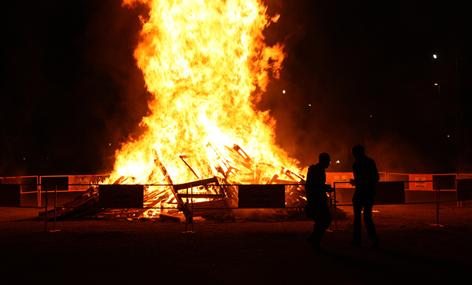Sant Joan's Eve sets Barcelona ablaze with energy
Every year the sounds of fireworks popping and crackling perforate the air in Catalonia in the days leading up to Sant Joan's Eve (Nit de Sant Joan). The yearly festival culminates in a massive party on the night of 23 June, when locals celebrate the holiday by setting off mass amounts of fireworks and igniting bonfires, known in Catalan as 'fogueres'. At midnight, there is a spectacular fireworks display, marking the climax of the celebration. The bonfires of Sant Joan have special meaning for Catalan-speaking regions, and the festival is considered a Catalan national holiday. The tradition as it exists today traces its roots back to pagan rituals and coincides with the summer solstice, marking the beginning of the summer.

Barcelona (ACN) – Every year the sounds of fireworks popping and crackling perforate the air in Catalonia in the days leading up to Sant Joan's Eve (Nit de Sant Joan). The yearly festival culminates in a massive party on the night of 23 June, when locals celebrate the holiday by setting off mass amounts of fireworks and igniting bonfires, known in Catalan as 'fogueres'. At midnight, there is a spectacular fireworks display, marking the climax of the celebration. The bonfires of Sant Joan have special meaning for Catalan-speaking regions, and the festival is considered a Catalan national holiday. The tradition as it exists today traces its roots back to pagan rituals and coincides with the summer solstice, marking the beginning of the summer.
The Sant Joan festival's most distinguishable trait is the abundance of fires burning throughout the city. The holiday is also known as the 'Night of Fire' (Nit de Foc) for this reason. Bonfires can be found in many city squares but appear in the highest concentration along the beaches, freckling the sands of the Mediterranean with flames.
The origins of the festival date back to ancient pagan rituals celebrating the arrival of the summer solstice, the longest day of the year. The flames, therefore, are emblematic of the sun's heat and its peak position in the sky during the summer solstice, the shortest night of the year.
As the European population transitioned to Christianity, Saint John the Baptist became the festival's namesake. Keeping in line with this tie to baptism and cleansing, a tradition of the festival is to leap across the bonfire three times to cleanse your worries. According to Christian texts, John the Baptist was born about six months before Jesus, which is why its date is six months before Christmas. The holiday itself is on 24 June, but the majority of festivities happen the night before.
Watch out for firecrackers
At every Sant Joan celebration, fireworks and bonfires accompany each other like thunder and lightning. During the days leading up to Sant Joan's Eve, temporary fireworks kiosks are set up and fireworks crackle and boom at random hours, serving as a reminder for the festival to come.
On the 23rd, however, the frequency of firework explosions increases throughout the day until the pops are nearly constant. By night, people dressed in devil costumes dance around the raging bonfires with sparklers while bystanders set off their firecrackers. At midnight, the festivities reach their peak, and those celebrating on the beach marvel as a massive fireworks display ignites the sky over the Mediterranean and people set off whatever firecrackers they have left. Once midnight strikes, the intensity of the fireworks is sustained for hours on end.
Distinctly Catalan
Sant Joan is most popular among the autonomous communities of Catalonia and Valencia. Because of Sant Joan's strong ties to Catalan-speaking areas, 24 June is considered a Catalan national holiday. The festivity, however, is also celebrated in other regions such as Galicia.
In Catalonia, the most important tradition is the Canigó Flame (Flama del Canigó). On 22 June, a giant beacon is lit on the peak of Canigó in the easternmost part of the Pyrenees, from which people light torches and distribute them throughout the Catalan Countries.
Inspired by the epic poem 'Canigó' by Jacint Verdaguer, Francesc Pujades, a hiker from Northern Catalonia, first lit the fire atop Canigó in 1955. At first, the practice was kept a secret from the Francoist dictatorship and was a symbol of the vitality of Catalan identity. The flame now travels from Canigó to all of Catalonia, Catalan parts of France, Andorra, Valencia and western parts of Aragon, reaching more than 350 municipalities each year.
More traditions
The most obvious symbol of the Sant Joan festival is fire, but water and herbs are considered to be symbols as well. The water represents healing, and for this reason it is common for people to bathe in the sea during Sant Joan. Herbs symbolise remedy, and it is said that their healing qualities are amplified on Sant Joan's Eve. One such herb, Saint John's Wort, is particularly associated with this holiday, and women have been known to pick the herb as part of the celebration.
The customary food of Sant Joan's Eve is a rectangular, sweet bread topped with candied fruit, known as 'coca'. Some variations of 'coques' are filled with cream or topped with sesame seeds.